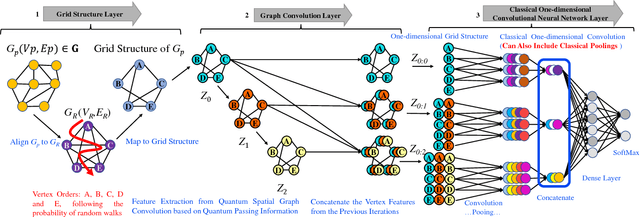A Quantum Spatial Graph Convolutional Neural Network using Quantum Passing Information
Paper and Code
Sep 04, 2018



In this paper, we develop a new Quantum Spatial Graph Convolutional Neural Network (QSGCNN) model that can directly learn a classification function for graphs of arbitrary sizes. Unlike state-of-the-art Graph Convolutional Neural Network (GCN) models, the proposed QSGCNN model incorporates the process of identifying transitive aligned vertices between graphs, and transforms arbitrary sized graphs into fixed-sized aligned vertex grid structures. To further learn representative graph characteristics, a new quantum spatial graph convolution is proposed and employed to extract multi-scale vertex features, in terms of quantum passing information between grid vertices of each graph. Since the quantum spatial convolution preserves the property of the input grid structures, the proposed QSGCNN model allows to directly employ the traditional convolutional neural network to further learn from the global graph topology, providing an end-to-end deep learning architecture that integrates the graph representation and learning in the quantum spatial graph convolution layer and the traditional convolutional layer for graph classifications. We demonstrate the effectiveness of the proposed QSGCNN model in terms of the theoretical connections to state-of-the-art methods. The proposed QSGCNN model addresses the shortcomings of information loss and imprecise information representation arising in existing GCN models associated with SortPooling or SumPooling layers. Experimental results on benchmark graph classification datasets demonstrate the effectiveness of the proposed QSGCNN model.
 Add to Chrome
Add to Chrome Add to Firefox
Add to Firefox Add to Edge
Add to Edge